PAPUA NEW GUINEA TRIP LOG
Day 1 – Cairns Departure
Wednesday the 30th of October 2019
Guests cleared immigration from 0730 on Trinity Wharf in Cairns and were greeted by Captain Jacopo Barchetti (JB) and crew on board the Coral Adventurer. After settling into cabins, everyone assembled in the Bridge Deck Lounge, where Purser Udo Soltwedel introduced the crew and ran us through safety drills, starting with a mandatory introduction to the life jackets! We left port at 0900, cruising out of Trinity Inlet before heading north for Papua New Guinea.
After the first of many excellent meals at lunch in the Dining Room, Expedition Leader Jamie Anderson introduced the Expedition Crew, who would be guiding activities and providing much of the information to guests on shore expeditions. Jamie described the exciting program ahead of us, drawing attention to the protocols of shore visits.
The Captain’s Welcome Drinks in the Bridge Deck Lounge allowed us to meet JB, and Jamie provided the first of his daily briefings on plans for the next day. Following a delightful dinner prepared by Chef Mohammed’s galley, we were treated to the sight of a very youthful David Attenborough trekking around New Guinea in the documentary, ‘A Blank on the Map’.
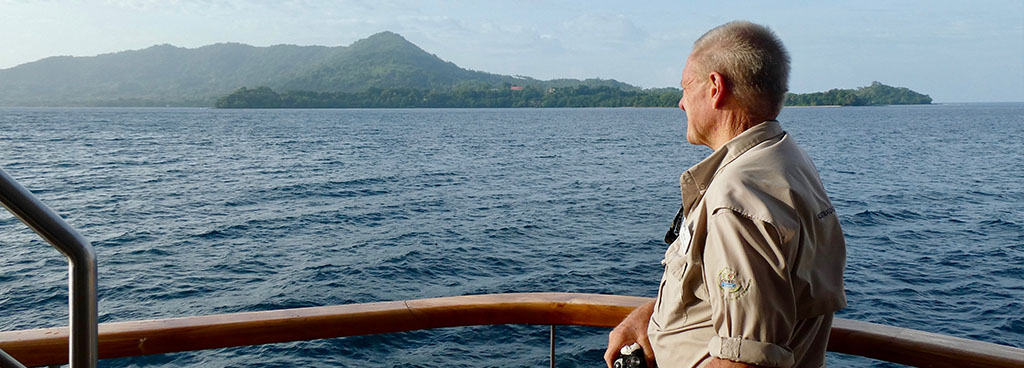
Day 2 – Crossing the Coral Sea
Thursday the 1st November 2019
This was a full day at sea, cruising across the Coral Sea that separates Australia from Papua New Guinea (PNG). Until about 7,000 years ago, New Guinea and Australia were joined by a land bridge across the Torres Strait and formed a single continent known as Sahul. After breakfast, Guest Lecturer Chris described the pre-colonial history of New Guinea in a talk on ‘The First Settlers‘, ranging from the origins of the Papuans to the local invention of agriculture 9,000 years ago. Morning tea was followed by marine biologist and crew member Marysia’s presentation on the “Mysteries of the Coral Triangle”, the world’s most bio-diverse marine region which includes the waters of PNG.
A filling lunch was followed by an introduction to dive and snorkel protocols by Dive Instructor Patrick, before we were all fitted out with masks and fins. Chris gave his second presentation on the day, on ‘Colonial New Guinea‘, describing the first encounters between Europeans and Papua New Guineans, on the coast since 1606 and then in the Highlands from 1930. Pre-dinner drinks and a briefing on our first day in PNG, followed by dinner and then an evening screening of the BBC documentary ‘Birds of Paradise‘, rounded off an informative day at sea.
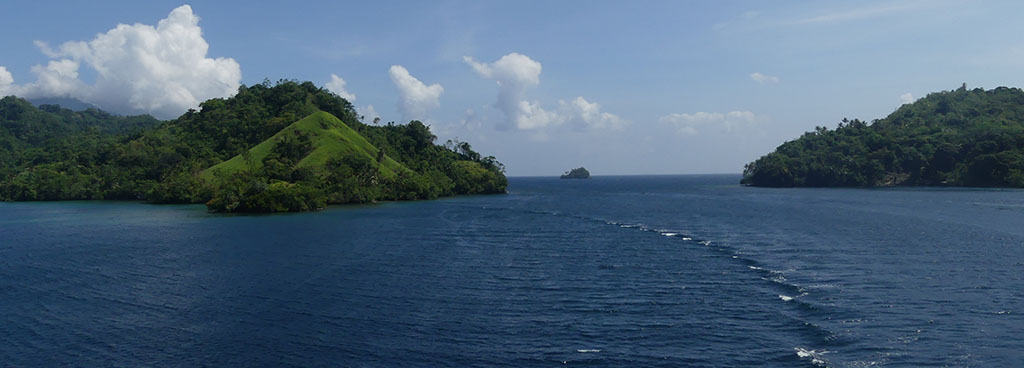
Day 3 – Samarai Island and Sewa Bay
Friday the 2nd November 2019
First light revealed the looming mountains of the PNG mainland to port, and a series of small islands to starboard. Three spinner dolphins piloted the ship towards the China Strait, an old trading sea route between Australia, Japan and China, and by breakfast we were anchored off the tiny island of Samarai in PNG’s Milne Bay Province. Samarai was once the ‘Jewel of the Pacific’, colonial Papua’s second-largest town, graced with manicured gardens and waterfront promenades, stately planter’s homes and two-storey wooden hotels; but it was largely destroyed in 1942 ahead of the Japanese advance, and has never recovered its former glory.
We were joined in Samarai by Alex Paira from Melanesian Tourist Services who was an essential part of the operation as he and his colleagues provide the critical link between the Expedition team and local communities. Once we had been cleared by PNG Immigration officials coming out of the local provincial capital of Alotau, Captain JB set course for the D’Entrecasteaux Islands, named in honour of the first French explorer to pass through these islands. Ahead of lunch, Chris gave a talk on the ‘Cultures of Papua New Guinea‘, describing life amongst communities as diverse as the Hagahai of the Schrader Ranges, the highlands’ Huli people of Hela Province, the Lihir islanders north of New Ireland, and the famed Trobriand Islanders.
After lunch, we edged through the narrow passage into beautiful Sewa Bay, on the west coast of Normanby Island, where the Xplorer landed us on the beach at Pwanapwana village. We were greeted by a throng of children and their parents, and led along an avenue of trees to the grounds of the community school. Seated under an L-shaped canopy of pandanus thatch, we were treated to a series of dances by the school children, all dressed in traditional clothing, and then led to a series of different demonstrations of pandanus weaving, sago processing and local cooking. Many of the school teachers and children kindly guided us up the hill behind the school and into their homes, and then the entire community followed us down to the water’s edge, where Bosun Bryan revved up the Xplorer’s engines, showering the more adventurous kids with spray, to their absolute delight.
At pre-dinner drinks in the Bridge Deck Lounge, Jamie gave a recap of the day’s events and outlined the program for the next day, and after another excellent dinner, the documentary film ‘First Contact’ was screened, recounting the incredible journey of the Leahy brothers foray into the unexplored interior highlands of New Guinea in 1930.
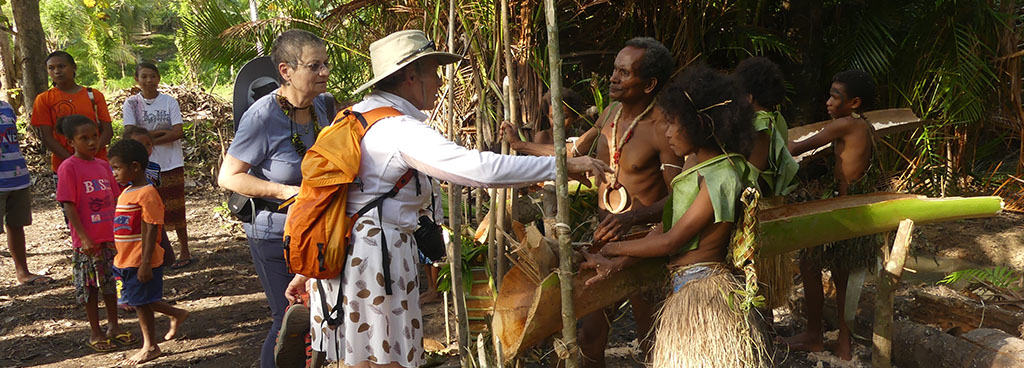
Day 4 – Dei Dei (Ferguson Island) & Dobu Island
Sunday 3rd of November 2019
We had left Sewa Bay in the last of the light yesterday, and after cruising a short distance overnight up the west coast of Normanby, we found ourselves anchored off Palagwa Village on neighbouring Fergusson Island. A number of dances by performers concluded with a long dramatization of a story about a woman trapped in a tree from which she had been harvesting leaves by her cousin sister, an evil witch. Once her parents had found and released her, her father tricked the witch into approaching and then leaped up to kill her, to huge approval from the crowd. Fine local carvings and other wares were available to purchase, including many beautifully polished stone axes which we had to inspect but not purchase, as they are prohibited both as exports from PNG and imports to Australia.
Following these performances, small groups were led along a dirt road to the remarkable Dei Dei hot springs, a series of geysers and steaming and bubbling pools with dramatically different colours ranging from bright yellow to an iridescent blue. Stepping carefully around the pools, many of them associated with stories of individuals being scalded to death in the past as our guides recounted rather brightly, we returned to Palagwa and the cool of the breeze off the sea. A smaller group made the short trip to the mission station of Boduya with Alex and Jamie. Guests visited the local clinic and school where some much needed supplies and equipment were donated by Coral Expeditions and guests.
Lifting anchor over lunch, we cruised a short distance down the strait between Fergusson and Normanby Island to take up a position off the smaller conical volcanic island of Dobu, its ash slopes deeply scored by eroded valleys. With volcanoes to our right and left, and geysers and vents elsewhere we were now well within the Ring of Fire! We were also now in the area known as the Kula ring, a traditional network of exchange involving ancient shell and stone valuables in which Dobu Island played a central part. Senior chiefs in the hierarchical societies of these islands continue to participate in these competitive and prestige exchanges which see white armshells called mwali move in a more or less counter-clockwise direction between the D’Entrecasteaux and Trobriand Island groups, against a counter-current of bagi shell necklaces moving clockwise. Dobu is one of the most famous mission stations in PNG, with an old church bearing the name of the first missionary, William Bromilow, and where we were treated to delightful renditions of the national anthem by schoolchildren, followed by dances and a display of Kula valuables, strung out along a pole.
Our group then divided, some returning to the comforts of the ship, others staying to enjoy extended conversations on Dobu, and a third party diving and snorkelling in one of the best spots of the expedition, above a series of tiny vents releasing streams of warm bubbles. Once back on board guests enjoyed pre-dinner drinks accompanied by a recap of a full day of activities. An after-dinner screening of the documentary ‘Lost Mummies of Papua New Guinea‘ introduced guests to some of New Guinea’s more unusual secrets.
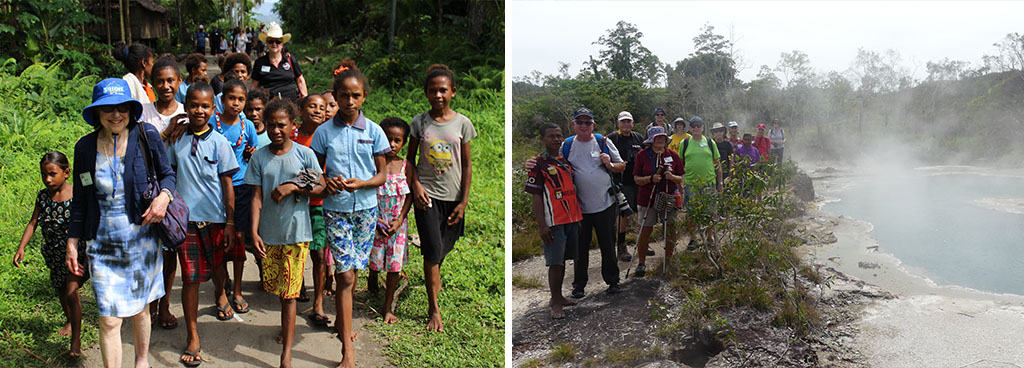
Day 5 – Kuiawa Island (Trobriand Islands)
Monday the 4th November 2019
Morning found us in the spectacular but remote Trobriand Islands. While still part of the Milne Bay Province this island group is very distinct both culturally and geographically from the rest of the province and from the rest of PNG in general, with strong chiefly hierarchies and dances that resemble those of Polynesia.
At 0800 we headed ashore to magical Kuiawa on the Xplorer. Even within the Trobriand Islands, Kuiawa is relatively remote and removed from the main island of Kiriwina, and the local villagers were out in force to greet us. We were given an official welcome and then enjoyed several traditional Trobriand dances and songs performed by all age groups. The costumes, instruments and style of dancing were notably different to anything we had experienced so far. The Trobriands are expert carvers and their style is unique. Proud mothers and sisters would dash out from the crowd to hang shell necklaces over the dancers. As guests were shown through the village by enthusiastic guides there were small stalls along the way where we could purchase our own piece of the Trobriands and take home an expertly made carving or woven basket.
After lunch on board the ship, it was time to get in the water and enjoy some excellent snorkelling on the reef at the entrance to Kuiawa village. Other guests chose to return to shore and spend more time in the village.
Afternoon tea was available as guests returned to the vessel and at 1630 Chris gave a presentation on the Kokoda Track and the Pacific War, sketching Japanese and Allied strategies as a context for the particular battles of Milne Bay, Kokoda, and the Buna-Sananada-Gona beachheads, one of our forthcoming destinations. The evening’s film screening was a documentary by John Boyle, entitled ‘Klin Wara: Ultimate Papua New Guinea‘, on the extraordinary wealth of PNG’s undersea worlds.
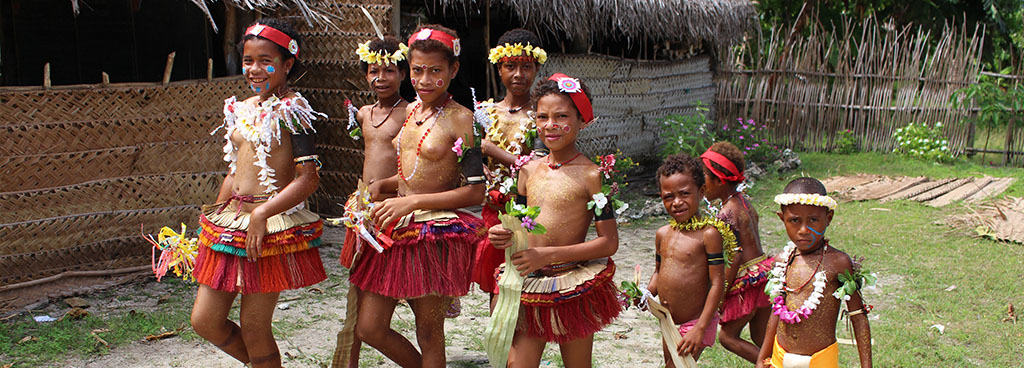
Day 6 – Tufi Fjord & Natade Village
Tuesday the 5th November 2019
A long cruise through the night brought us to the spectacular fjords of Tufi at sunrise, with the active volcanic peaks of Mount Trafalgar looming behind them. The fjords have been created by lava flowing down from these peaks, through which the sea has sculpted fingers of ocean, creating narrow steep-sided gorges. By 0800, we were in the Xplorer, heading into one of these fjords opposite Natade.
Traditional canoes expertly steered by children and led by a magnificent leader standing on a canoe platform to deliver his welcome, ferried us across to a welcome by black-painted warriors and girls throwing petals. On a grassy expanse in the pretty village of Natade, dancers performed for us, dressed in beaten barkcloth or tapa, decorated with ancient clan designs, and sporting elaborate headdresses topped with the plumes of Raggiana birds-of-paradise, cassowary and cockatoos. This was followed by a number of well-designed demonstrations of traditional practices, including the tattooing of women’s faces, fire-making, the production and decoration of tapa, and the application of traditional medicines. A stunning range of local artefacts, including lengths of decorated tapa, shell necklaces and string bags, was available in a market that sprang up out of nowhere, and the dancers continued to beat their drums long after we had filed back to the landing and returned to the ship for lunch.
After lunch guests returned on the Xplorer either to dive and snorkel along one of the fjord cliffs, or to visit Tufi Dive Resort, which involved a steep but short climb to a spectacular view up the largest of the fjords, and encounters with some of PNG’s most iconic wildlife, including a lovely and inquisitive spotted white Cuscus, Eclectus parrots and a large hornbill. We were all back on the ship by 1700 as another busy but thoroughly enjoyable day came to a close. The evening’s entertainment divided between a screening of Kate Winslet’s film ‘The Dressmaker‘, and an informal discussion with Chris in the Barralong room on topics including cannibalism and warfare.
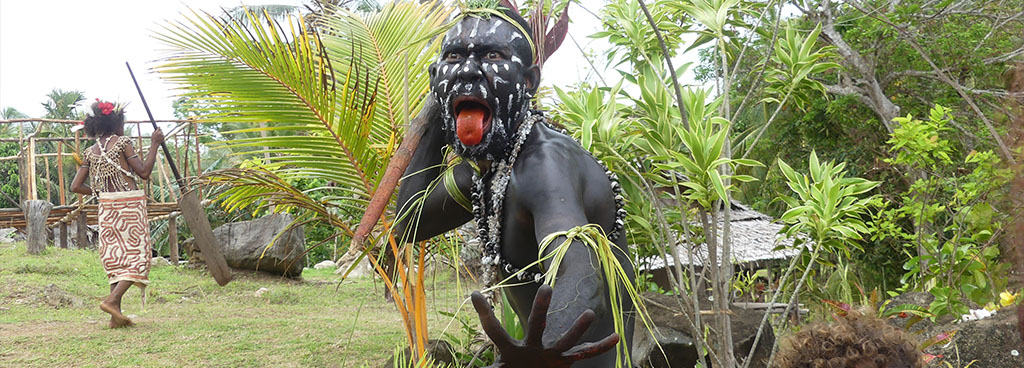
Day 7 – Buna & Sanananda
Wednesday the 6th of November 2019
Another night time cruise brought us to the beachhead battle sites of Buna and Sanananda, which saw some of the bloodiest fighting of the New Guinea campaigns during World War II.
The Xplorer landed us, much like troops in the war, on the black sand beach of Buna, only we were greeted by a line of beautiful children wearing traditional costumes and placing flower garlands over our heads. We then enjoyed a powerful traditional dance by senior men beating hand drums and women holding sheets of tapa barkcloth over their heads.
From there some walked in groups along the long beach while others took the Xplorer to Buna government station, where we read a number of commemorative plaques put up in memory of fallen US and Australian soldiers. Passing an aircraft wing inserted vertically into the ground, we walked up a long straight road through Buna village, visiting the local medical aid post and a small community museum which had been opened just the day before, stocked with helmets, weapons and the other debris of war found in the surrounding fields.
Back on board the ship, we restored our energy with lunch while the Captain steered us a short distance up the coast to neighbouring Sanananda, where the Australians coming down from the Kokoda Track had fought the surviving Japanese forces in hand to hand combat. Another, smaller dance group welcomed us on the beach, and most of our party then headed in search of the original battlefield, now set back from the current beach by a long sandbar that formed in 1951 after the Mount Lamington eruption. High tide obscured the Japanese landing barges lying on the original beach, now the bank of an enchanting tree-lined river. A local boatman ferried us across the river to see another small collection of war relics and then the commemorative plaques for the Australian forces, carefully tended to and guarded by an older man, Ananias, who was delighted to show us around. The day came to a close after dinner with the documentary ‘Lost Land of the Volcano‘.
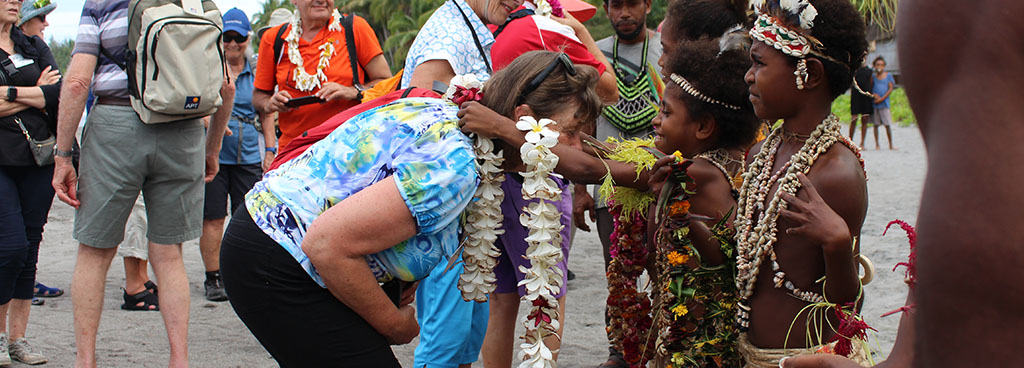
Day 8 – Mou Village & Morobe Harbour
Thursday the 7th November 2019
Moving further up the northern coast, we crossed the old border between British New Guinea or Papua, with its English-speaking Methodist and Anglican missions, and former German New Guinea, which featured German Lutheran missionaries , just across from the government station of Morobe, after which the province is now named.
A group of early birds ventured out at 0600 to cruise up several of the rivers in the Xplorer in search of other early birds, spotting honeyeater nests and waterbirds along the banks. The welcome after breakfast at Mou was amongst the highlights of the trip, with vigorous dances and an enthusiastic community that absolutely delighted in showing us their houses and their lives.
After lunch, the Xplorer and two zodiacs took us into Eware lagoon, across a ‘horizontal waterfall’ at the lagoon mouth, before we slowly cruised up several rivers, which seemed much busier with birdlife than they had been at dawn. Pre-dinner drinks on the top deck and a barbecue dinner played out against the spectacle of the sun setting over the mountain peaks, and small canoes flitting across the harbour.
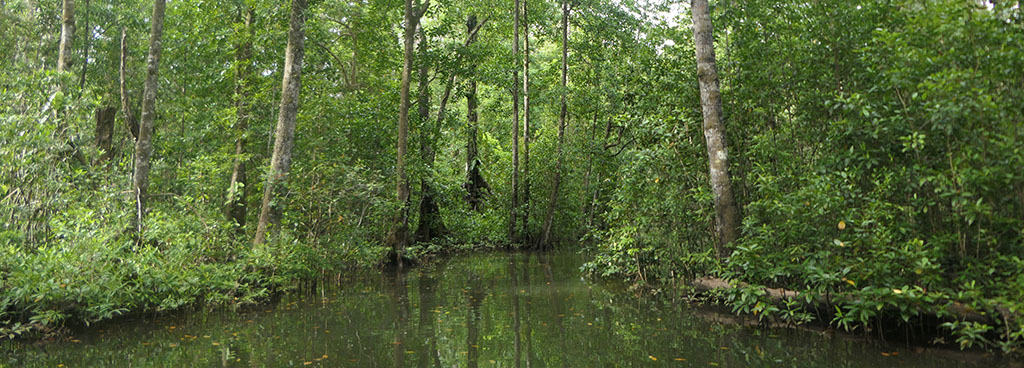
Day 9 – Fly Island & Lababia
Friday the 8th November 2019
Dawn found us cruising into the Fly Island group, where we anchored off the uninhabited island of Bianagutu. After breakfast, the Xplorer took divers and snorkelers to the island’s fringing reef, which was teeming with marine life. Overcast conditions reduced the colours of the reef, but we were treated to a pod of some 50 spinner dolphins leaping around the ship.
Back on the ship, Chris gave a presentation on the adventures and detailed drawings of the Russian naturalist Nikolai Miklouho-Maclay, who travelled through New Guinea, the Malay Archipelago and Island Melanesia between 1870-1883. Meanwhile we weighed anchor and headed through Royle Channel for Lababia and Nassau Bay.
After lunch, the Xplorer landed us on the beach at the village of Kamiali, the mainland residence of islanders from Lababia Island. The only access to this area is by sea as there are no roads and no airstrip, and it is thus the perfect location for the large nature reserve in the valleys and mountains behind Kamiali, which has hosted a permanent research station for visiting scientists. Nine days of torrential rain in 2016 resulted in landslides that blocked, and then altered, the course of the river behind the village, and led to a long outbreak of malaria (now ended).
As we stood on the long palm-lined beach, a woven pandanus fence was knocked down to reveal a dance group, which led us into the centre of the village. A fine sing sing and passage through a small but rich market of local artefacts led to the river, up which many of us travelled on local outrigger canoes. The scale and impact of the landslides was clearly visable. The day concluded with pre-dinner drinks, dinner and a documentary called ‘Cultural Encounters in an Ancient World‘.
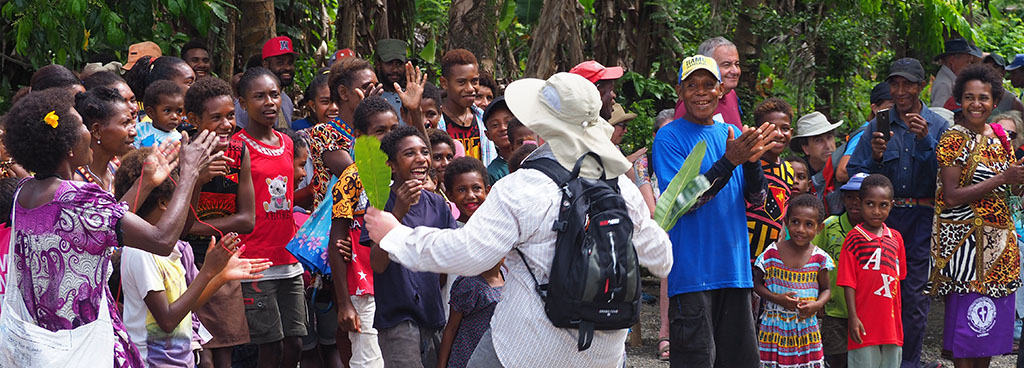
Day 10 – Dregerhafen
Thursday the 9th November 2019
Breakfast found us passing the Tami Islands to starboard on our approach to Dregerhafen, a charming harbour fringed by small islands. The village of Gingala on the Dregerhafen mainland is home today to most of the resettled Tami Islanders, along with a mixture of local Yabim people and immigrants from the Siassi Islands and Markham Valley. Dregerhafen, as its name suggests, had been a German colonial station with a Lutheran mission, and then a Japanese and later American naval base during the war.
While the community prepared for its performances, Chris gave a talk on volcanoes, past and present, reviewing the volcanoes we had already seen and some of those we would be passing over the next few days. At 0930 the Xplorer headed for the wharf at Gingala, where we were greeted by a delightful dance group of Yabim children, led by two boys wearing tall painted plaques. Our local MC, Steve, introduced the community, and four vigorous dance groups, which all performed simultaneously, as we wandered from one to another under a hot sun. The Yabim children were a highlight, with one group playing traditional children’s games (including seagulls diving for tuna, and a dog crossing a river), along with a Siassi Islands group, wearing white triangular hats, and some Markham Valley warriors beating their spears together. Passing through an excellent market featuring some of the famous Tami Island carved bowls and paddles and a spectacular black and white Tago cult mask from Tami, we were treated to the sight of a fully-clothed Patrick swinging into the harbor, before returning to the Coral Adventurer for lunch.
The afternoon was devoted to snorkelling off the Xplorer, exploring a fringing reef along Matura Island with some great anemones when before long the snorkelers were joined by local kids on a flotilla of small canoes. A quick recap of the day’s events at pre-dinner drinks was followed by dinner and then a lively documentary featuring comedian Bill Bailey travelling in the footsteps of Alfred Russel Wallace from Borneo east as far as Lombok.
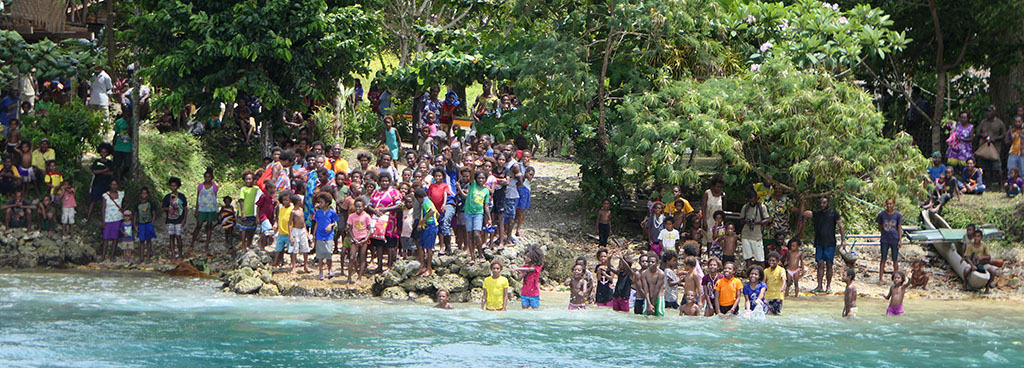
Day 11 – Karkar Island
Sunday the 10th November 2019
Overnight we passed around the Huon Peninsula, and the western tip of New Britain, waking for a ‘late’ breakfast at 0730 with volcanic Bagabag Island to starboard and Madang and Miklouho-Maclay’s old residence on the Rai coast to port.
After breakfast, Marysia treated us to a great presentation on the strange habits of the marine life of PNG, including sex-changing clownfish, dolphins playing football with pufferfish, and sea cucumbers hosting pearlfish parties! A break for coffee was followed by Captain JB’s introduction to the history of marine navigation and some of the technological innovations now available to him as Master of Coral Adventurer.
We lunched on the ship, now anchored between the New Guinea mainland and our destination for the afternoon, Karkar Island. Karkar is formed around a large volcanic crater, which has been quiet of late, but killed two volcanologists in 1979. The island’s rich soils support an almost continuous string of plantations along the coast, and a dense of population of as many as 80,000 people.
The Xplorer landed us on the beach at Kar Kar Estates Plantation where we were greeted by a fierce warrior, accompanied by a traditional dance group. Festivities and dances continued nearby, where a lively Master of Ceremonies revved up the crowd and introduced our hosts, plantation managers Barbara and Paul Goodyear, their local supervisors and the nearby communities. Guides led us through the cocoa and copra processing yards, explaining how both crops are harvested and prepared for shipment, and the grafting technology being used to combat the spread of cocoa borer. We then wandered through the milling crowds, watching performances on large bamboo pipes (adopted from the Solomon Islands) and on the traditional garamut slit drums; admiring and occasionally buying the distinctive string bilums of Karkar.
Once all were back on board, some took advantage of the breeze and the view to enjoy a coffee on the different decks, while others headed back on the Xplorer to a delightful cove on Karkar where visibility of 10 metres or more made for excellent snorkeling on the reef.
Guest photographer David Kirkland presented a selection of his professional images of the expedition thus far during evening drinks, followed by a slideshow of crew photos. After dinner, the second part of the Bill Bailey’s entertaining Wallace documentary, ‘Alfred Russel Wallace in the Spice Islands‘, was shown in the Bridge Deck Lounge, while the ship weighed anchor and headed west for the Sepik River.
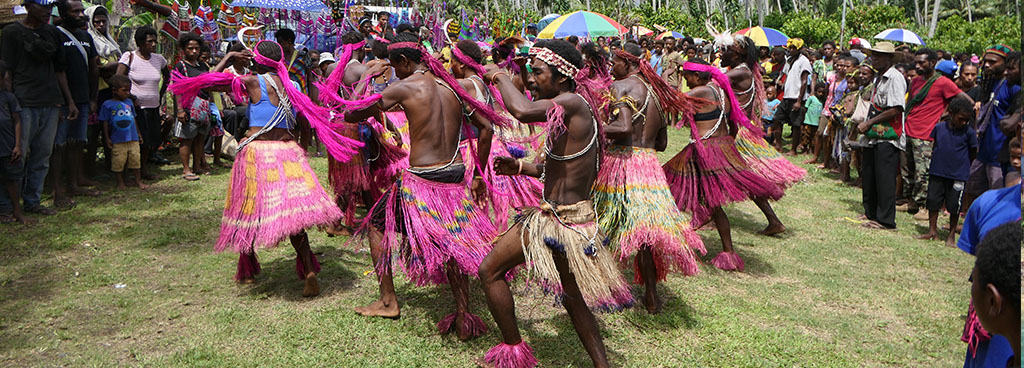
Day 12 – Sepik River, Bin Village & Kadover Island
Monday the 11th November 2019
After cruising through the night from Karkar, we reached the mouth of the mighty Sepik River at 0545, and began our ascent of the river. The early birds on deck were treated to an abundance of water fowl, and remarkable vistas from the upper decks which allowed us to see distant ridges and mountains above the palms and trees, and to follow the winding course of the river, which almost doubles back on itself. Long thin dugout canoes, characteristic of the Sepik, shot out from the banks as we passed “summer” camps of scattered thatch houses, which people occupy briefly while they fish, process sago, and collect bananas, prior to converging again on their main villages. At 1,126km in length, the Sepik is PNG’s longest river, a highway of trade and cultural exchange that is as important to PNG as the Amazon and the Nile are to Brazil and Egypt.
As guests enjoyed a late breakfast, the ship sailed 59 kilometres upstream to the village of Bin or Bien, our anchorage for the morning and the home of people speaking the Kanda language. Children raced along the river banks to our landing spot, some 500m below the community school grounds, where most of the local community were gathered to welcome us. On the way we noticed the fine Catholic church with carved posts and a painted front, illustrating scenes from the Bible using local imagery.
We were welcomed by a group of men and women performing a dance formerly restricted to men and seen only within the sacred tambaran house, and were then seated in front of a rendition of the PNG National Anthem by the village schoolchildren, accompanied by the raising of the national and provincial flags. This was followed by a series of dances and dramatisations, including a stunning performance by a young man and his ‘mother’, illustrating scenes from their lives and culminating in his attack and possession by four bush spirits. Once the program was complete and Jamie had conducted his customary vote of thanks and handing over of gifts to the local headmaster, guests wandered through the largest and richest market that we had seen, many of us returning to the ship clutching a broad variety of carvings, beadwork and woven bilums. The ship’s flag was flying at half-mast, to mark Remembrance Day.
Lunch was served as we began the return journey down the Sepik, and Chris and Meredith gave a final presentation on the ‘Cultural Heritage of the Pacific‘, drawing on their experience as advisers to the community managers of Vanuatu’s “Chief Roi Mata’s Domain” World Heritage site to reflect on the future of PNG’s rich cultural heritage, and then fielding questions about our experiences over the course of the Expedition.
Meanwhile Captain JB steered us out of the Sepik mouth and across to within 1km of the active volcano at Kadover Island, which obliged by pumping out a column of steam and ash and even rolling a few hot boulders down its slopes to the sea. This spectacular sight provided the perfect backdrop for the Captain’s Farewell Drinks and a series of heartfelt speeches and thanks on the part of both the crew and guests. After dinner and a final farewell to the ship’s hospitality crew, Dave led a hilarious PNG Trivia Night quiz to determine who had managed to stay awake longest during the cruise lectures and other events.
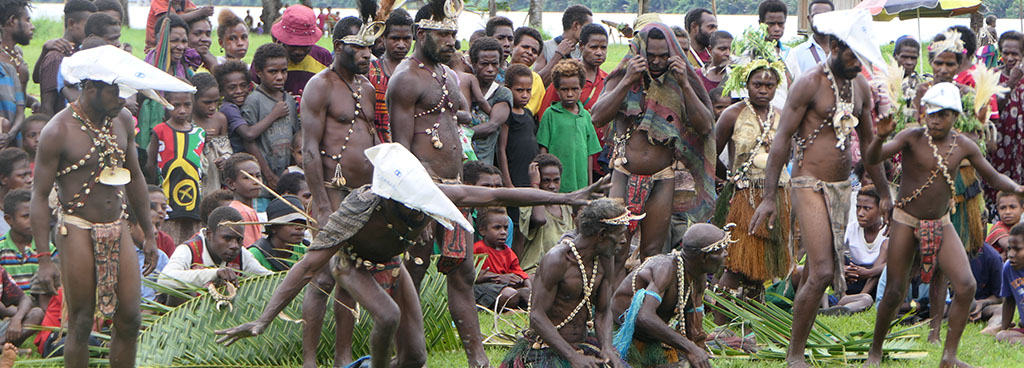
Day 13 – Madang
Tuesday the 12th November 2019
Overnight, the Coral Adventurer cruised from Kadover Island to our final destination at the town of Madang, the capital of Madang Province. After an early breakfast the group headed in different directions, with the Israeli party setting off to the north on their own tour, and the main group boarding two buses which took us through Madang for a morning of sightseeing.
Your Ship’s Crew on this voyage consisted of:
Captain Jacopo (“JB”)
Chief Officer Dan
Second Officer Verity
Chief Engineer Dave
First Engineer Ali
Second Engineer Vinnie
Bosun Brian
Deck Crew Mitchell, Wairu, Emily, Darryl
Expedition Leader Jamie
Expedition Assistant Dave
Expedition Crew Marysia, Annie,
Dive Instructor Patrick
Purser Udo
Assistant Purser Mikaela
Snr. Cruise Attendants Mathew, Marisa
Cruise Attendants Camille, Annie, Prue, Mirinda, Hugo, Brooke, Sam, Sarah A, Sarah J, Scotty, Jewels, Jake, Jono
Chef Mohammed
Galley Crew Jeevan, Scott
Melanesian Tourist Services Alex
Guest Lecturer Chris
Captain Jacopo Barchetti, officers and the entire crew of Coral Discoverer would like to thank you for travelling with us on this cruise through ‘The Land That Time Forgot’. It has been our pleasure to have you aboard and we hope to see you again on the high seas.
Goodbye for now and have a safe journey home.
Written by Chris Ballard – Guest Lecturer.






